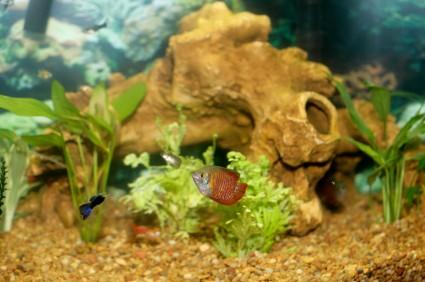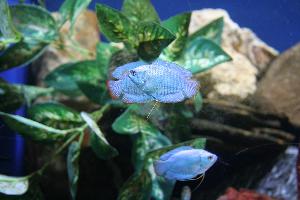Dwarf Gourami

The dwarf gourami (Colisa lalia) is from India and belongs to the family Belontiidae. It possesses a labyrinth organ that allows it to breath atmospheric oxygen. The labyrinth organ evolved in species that frequently found themselves in low oxygenated water. You will frequently see dwarf gouramis come to the surface for gulps of air. The males also use the labyrinth organ for bubblenest building prior to spawning.
Gouramis have been selectively bred and now there are several color variations available, red, blue, neon, and rainbow. The most frequently encountered dwarf gourami is blue.
Dwarf gouramis are smaller than other gouramis as their name suggests. They reach a size of about 2 inches in length or about 5 cm. They are peaceful fish that can be kept in a community tank with other nonaggressive species. It is best to keep them in pairs (or even several pairs). They enjoy a planted aquarium with soft, slightly acidic water (pH about 6.8), and a water temperature of between 77-82 degrees Fahrenheit or 25-28 degrees Celsius.

They will eat flakes, frozen, freeze-dried, and live foods.
Spawning and Fry
They are egglaying fish and will breed in the aquarium. Dwarf gouramis are easy to sex because the male is much more colorful than the female. As mentioned earlier, they are happiest when kept in pairs, and so you should already have a male and female in your tank. Unfortunately, I have found that it is very hard to find female dwarf gouramis. This is probably because they are less colorful than the males and so the demand for them isn't as high. Recently I went to 3 different pet stores looking for females and found none. I ended up ordering two females online from Aquariumfish.net, which was the only place I could find females. They had plenty of them available in all different varieties.
If you are lucky enough to have obtained a male and female and they are ready to spawn you should place the pair into a breeding tank. They are most likely to spawn in slow moving or still water. Sometimes the filter will agitate the water too much and gouramis won't spawn. Years ago the electricity went out for a short time and a few days later I had baby gouramis in a community tank. I believe this was due to the filter being turned off and therefore there was less water movement.
Prior to spawning the male builds a bubblenest at the surface of the aquarium, often incorporating plants into the nest. It is important to have floating plants in your aquarium for this species. After the bubblenest is complete, spawning should take place.
After spawning is over, which may take several hours, remove the female, but leave the male with the eggs. He will guard the eggs in the bubblenest, which will hatch about 24-48 hours later.
When the fry become free swimming in about 2-3 days remove the male or he may eat them. When the fry are free-swimming they should be fed liquid fry food for egg laying fish, infusoria, rotifers, and when they are little older and can eat them, newly hatched brine shrimp.
The dwarf gourami sometimes spawns with other species of Colisa, such as the thick-lipped gourami and the banded gourami, however, the resulting fry are sterile.
